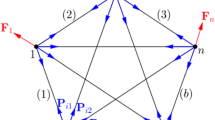Abstract
As 3D digital photographic and scanning devices produce higher resolution images, acquired geometric data sets grow more complex in terms of the modeled objects’ size, geometry, and topology. As a consequence, point-sampled geometry is becoming ubiquitous in graphics and geometric information processing, and poses new challenges which have not been fully resolved by the state-of-art graphical techniques. In this paper, we address the challenges by proposing a meshless computational framework for dynamic modeling and simulation of solids and thin-shells represented as point samples. Our meshless framework can directly compute the elastic deformation and fracture propagation for any scanned point geometry, without the need of converting them to polygonal meshes or higher order spline representations. We address the necessary computational techniques, such as Moving Least Squares, Hierarchical Discretization, and Modal Warping, to effectively and efficiently compute the physical simulation in real-time. This meshless computational framework aims to bridge the gap between the point-sampled geometry with physics-based modeling and simulation governed by partial differential equations.
Similar content being viewed by others
References
Farin G. Curves and Surfaces for CAGD: A Practical Guide. 5th ed. San Francisco: Morgan-Kaufmann, 2001. 119–146
Malladi R, Sethian J A, Vemuri B C. Shape modeling with front propagation: A level set approach. IEEE Trans Pattern Anal, 1995, 17: 158–175
DeRose T, Kass M, Truong T. Subdivision surfaces in character animation. In: Cunningham S, Bransford W S, Cohen M F, eds. Proceedings of Siggraph’98. Orlando: ACM Press, 1998. 85–94
Levoy M, Pulli K, Curless B, et al. The digital Michelangelo project: 3D scanning of large statues. In: Proceedings of Siggraph’00. New Orleans: ACM Press, 2000. 131–144
O’Brien J F, Hodgins J K. Graphical modeling and animation of brittle fracture. In: Proceedings of Siggraph’99. Los Angeles: ACM Press, 1999. 137–146
Belytschko T, Krongauz Y, Organ D, et al. Meshless methods: an overview and recent developments. Comput Method Appl M, 1996, 139: 3–47
Li S, Liu W K. Meshfree particle methods and their applications. Appl Mech Rev, 2002, 54: 1–34
Desbrun M, Cani M P. Animating soft substances with implicit surfaces. In: Proceedings of Siggraph’95, 1995. 287–290
Müller M, Keiser R, Nealen A, et al. Point-based animation of elastic, plastic and melting objects. In: Badler N, Desbrun M, Boulic R, et al. eds. Proceedings of ACM Siggraph/Eurographics Symposium on Computer Animation. Grenoble: Eurographics Association, 2004. 141–151
Müller M, Heidelberger B, Teschner M, et al. Meshless deformations based on shape matching. ACM Trans Graph, 2005, 24(3): 471–478
Pauly M, Keiser R, Adams B, et al. Meshless animation of fracturing solids. ACM Trans Graph, 2005, 24(3): 957–964
Guo X, Qin H. Real-time meshless deformation. Comp Animat Virt World, 2005, 16(3–4): 189–200
Wicke M, Steinemann D, Gross M. Efficient animation of point-sampled thin shells. Comput Graph Forum, 2005, 24(3): 667–676
Belytschko T, Lu Y Y, Gu L. Element free galerkin methods. Int J Numer Meth Eng, 1994, 37: 229–256
Belytschko T, Lu Y Y, Gu L. Fracture and crack growth by element-free Galerkin methods. Model Simul Mat Sci Eng, 1994, 2: 519–534
Lancaster P, Salkauskas K. Surfaces generated by moving least squares methods. Math Comput, 1981. 367: 141–158
Pauly M, Keiser R, Kobbelt L, et al. Shape modeling with point-sampled geometry. ACM Trans Graph, 2003, 22(3): 641–650
Xie H, Wang J, Hua J, et al. Piecewise C1 continuous surface reconstruction of noisy point clouds via local implicit quadric regression. In: Turk G, van Wijk J, Moorhead R, eds. Proceedings of IEEE Visualization’03. Seattle. IEEE Computer Society, 2003. 91–98
Guo X, Hua J, Qin H. Scalar-function-driven editing on point set surfaces. IEEE Comput Graph, 2004, 24(4): 43–52
Ohtake Y, Belyaev A, Alexa M, et al. Multi-level partition of unity implicits. ACM Trans Graph, 2003, 22(3): 463–470
Klaas O, Shephard M. Automatic generation of octree-based three-dimensional discretizations for partition of unity methods. Comput Mech, 2000, 25: 296–304
Guo X, Li X, Bao Y, et al. Meshless thin-shell simulation based on global conformal parameterization. IEEE Trans Vis Comput Graph, 2006, 12(3): 375–385
Organ D, Fleming M, Terry T, et al. Continuous meshless approximations for nonconvex bodies by diffraction and transparency. Comput Mech, 1996, 18: 1–11
Cirak F, Ortiz M, Schröder P. Subdivision surfaces: a new paradigm for thin-shell finite element analysis. Int J Numer Meth Eng, 2000, 47(12): 2039–2072
Pentland A, Williams J. Good vibrations: model dynamics for graphics and animation. ACM Siggraph Comput Graph, 1989, 23(3): 207–214
James D, Pai D. Dyrt: dynamic response textures for real time deformation simulation with graphics hardware. In: Proceedings of Siggraph’02. San Antonio: ACM Press, 2002. 582–585
Hauser K, Shen C, O’Brien J. Interactive deformation using modal analysis with constraints. In: Möller T, Ware C, eds. Proceedings of Graphics Interface. Halifax: A K Peters, 2003. 247–255
Choi M G, Ko H S. Modal warping: real-time simulation of large rotational deformation and manipulation. IEEE Trans Vis Comput Graph, 2005, 11(1): 91–101
Baraff D, Witkin A. Large steps in cloth simulation. In: Cunningham S, Bransford W, Cohen M F, eds. Proceedings of Siggraph’98. Orlando: ACM Press, 1998. 43–54
Metaxas D, Terzopoulos D. Dynamic deformation of solid primitives with constraints. ACM Siggraph Comput Graph, 1992, 26(2): 309–312
Zwicker M, Pauly M, Knoll O, et al. Pointshop3D: an interactive system for point-based surface editing. ACM Trans Graph, 2002, 21(3): 322–329
Zhou K, Huang X, Xu W, et al. Direct manipulation of subdivision surfaces on GPUs. ACM Trans Graph, 2007, 26(3): 91
Author information
Authors and Affiliations
Corresponding authors
Additional information
Supported by the National Science Foundation (Grant Nos. CCF-0727098, IIS-0710819)
Rights and permissions
About this article
Cite this article
Guo, X., Qin, H. Meshless methods for physics-based modeling and simulation of deformable models. Sci. China Ser. F-Inf. Sci. 52, 401–417 (2009). https://doi.org/10.1007/s11432-009-0069-x
Received:
Accepted:
Published:
Issue Date:
DOI: https://doi.org/10.1007/s11432-009-0069-x




